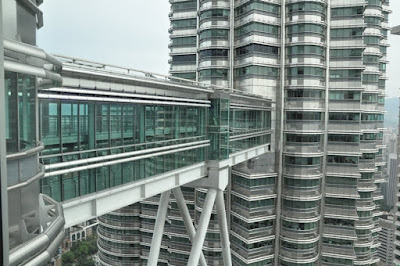SPONSORED
Construction of Petronas Twin Towers KLCC

Petronas Twin Towers, also known as Menara Berkembar Petronas in malay language, are twin skyscrapers in Kuala Lumpur, Malaysia. They were the tallest buildings in the world from 1998 to 2004 and remain the tallest twin towers in the world. The buildings are a landmark of Kuala Lumpur, along with nearby Kuala Lumpur Tower.
The tallest building in the world from 1 January 1998 to 31 December 2004
Built on 1 January 1992 until 31 December 1994, the Petronas Twin Towers was the tallest building in the world from 1 January 1998 to 31 December 2004. Currently, it still holds the record for the tallest twin buildings in the world. It is the headquarters of Petronas, a Fortune 100 state owned oil company and also the largest company in South East Asia.

The towers and the mall below were designed by Argentinian born architect César Pelli. Construction started in 1991 and completed 7 years after, in midst of Asian Financial Crisis and Reformasi movement. Due to the soil conditions on the tower, the buildings were built on one of the deepest foundations in the world. The Building Services Engineer was Flack + Kurtz who is currently part of the WSP | Parsons Brinkerhoff Company.
The 88-storey towers were built using mostly reinforced concrete, with steel-and-glass facade to resemble Islamic motifs, a religion followed by the majority of Malaysia. The cross section of the tower resembles Rub el Hizb, further solidifies the Islamic motif in the tower design.
The construction of the superstructure commenced on 1 April 1994. Interiors with furniture were completed on 1 January 1996, the spires of Tower 1 and Tower 2 were completed on 1 March 1996, and the first batch of Petronas personnel moved into the building on 1 January 1997. The building was officially opened by the Prime Minister of Malaysia's Tun Dr. Mahathir bin Mohamad on 1 August 1999.

The twin towers were built on the site of Kuala Lumpur's race track.Test boreholes found that the original construction site effectively sat on the edge of a cliff. One half of the site was decayed limestone while the other half was soft rock. The entire site was moved 61 metres (200 ft) to allow the buildings to sit entirely on the soft rock.
Petronas Twin Towers were built on the world's deepest foundations
Because of the depth of the bedrock, the buildings were built on the world's deepest foundations. 104 concrete piles, ranging from 60 to 114 metres (197 to 374 ft) deep, were bored into the ground. The concrete raft foundation, comprising 13,200 cubic metres (470,000 cu ft) of concrete was continuously poured through a period of 54 hours for each tower.
The raft is 4.6 metres (15 ft) thick, weighs 32,500 tonnes (35,800 tons) and held the world record for the largest concrete pour until 2007. The foundations were completed within 12 months by Bachy Soletanche and required massive amounts of concrete. The Petronas Towers' structural system is a tube in tube design, invented by Fazlur Rahman Khan. Applying a tube-structure for extreme tall buildings is a common phenomenon.

The 88-floor towers are constructed largely of reinforced concrete, with a steel and glass facade designed to resemble motifs found in Islamic art, a reflection of Malaysia's Muslim religion. Another Islamic influence on the design is that the cross section of the towers is based on a Rub el Hizb, albeit with circular sectors added to meet office space requirements.
The halt in construction had cost US$700,000 per day
Early into construction a batch of concrete failed a routine strength test causing construction to come to a complete halt. All the completed floors were tested but it was found that only one had used a bad batch and it was demolished. As a result of the concrete failure, each new batch was tested before being poured. The halt in construction had cost US$700,000 per day and led to three separate concrete plants being set up on the site to ensure that if one produced a bad batch, the other two could continue to supply concrete.

The sky bridge contract was completed by Kukdong Engineering & Construction. Tower 2 became the first to reach the world's tallest building at the time. When the structure reached about 72nd floor, tower 2 ran into problems. They discovered the structure was leaning 25 millimetres (0.98 in) off from vertical. To correct the lean, the next 16 floors were slanted back 20 millimetres (0.79 in) with specialist surveyors hired to check verticality twice a day until the building's completion.
The building twice as heavy on its foundation as a comparable steel building.
Due to the huge cost of importing steel, the towers were constructed on a cheaper radical design of super high-strength reinforced concrete. High-strength concrete is a material familiar to Asian contractors and twice as effective as steel in sway reduction; however, it makes the building twice as heavy on its foundation as a comparable steel building.
Supported by 23-by-23 metre concrete cores and an outer ring of widely spaced super columns, the towers use a sophisticated structural system that accommodates its slender profile and provides 560,000 square metres of column-free office space.


